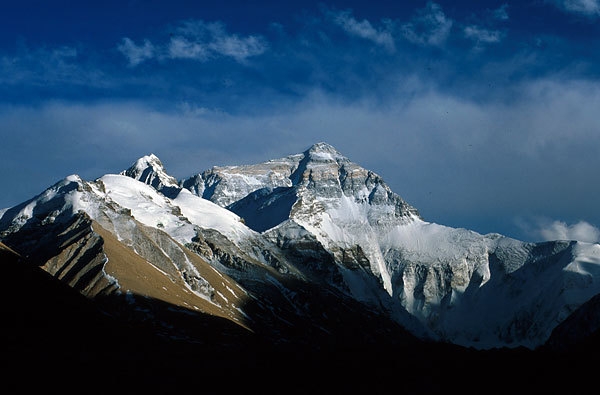Everest: Conrad Anker and Leo Houlding summit in the 1924 footsteps of Mallory and Irvine
On 14/06 Conrad Anker and Leo Houlding reached the summit of Everest following the footsteps of George Leigh Mallory and Andrew Irvine to shed light on the mystery of whether the two reached the summit of Everest on 8 June 1924.

 1 / 2
1 / 2
Everest from the north.
 Francesco Tremolada
Francesco Tremolada
Did Mallory and Irvine reach the summit of Everest in 1924? This question (and mystery) has kept historians busy for the last 83 years and although it still remains without a definitive answer, an important piece in the reconstruction jigsaw puzzle was added recently by two exceptional climbers: American Conrad Anker and Englishman Leo Houlding.
On 14 June the two reached the summit of Everest via the North Face, following in the footsteps of the two 1924 pioneer alpininsts. The idea was to find out whether Mallory and Irvine died before or after reaching the summit, but above all whether the two mountaineers would have been capable of climbing up the famous "Second Step". Located at circa 8600m, this 30m high section is considered the crux of the entire climb and it is probably here where they were last seen alive.
Anker and Houlding formed part of the "Altitude Everest" expedition led by Anker himself. To recreate the historical ascent the 2007 expedition chose to climb on the same days as Mallory and Irvine, and in fact the climbers were the last on the mountain in this busy pre-monsoon period. Importantly, the expedition received a special permit to remove the metal ladder used to overcome the Second Step.
This "aid" section dates back to 1975 when a Chinese expedition carrying out the second ascent via the North side hauled and fixed a ladder at circa 8600m. Anker and Houlding free climbed this section early on June 14 and after the climb Anker simply commented "that was hard." Three hours later the two were on the summit.
For the record, the route via the north side had also been climbed "free" in 1985 by Spaniard Oscar Cadiach and in 2001 by Swissmann Theo Fritsche. Both climbed without supplementary oxygen but both, obviously, had the psychological benefit of the ladder close by.
Â
The fact that Anker and Houlding managed to climb with Second Step in the same conditions as Mallory and Irvine adds further weight to the theory that the Englishmen might effectively have reached the summit in 1924.
In 1999 Conrad Anker discovered the body of George Leigh Mallory but even this discovery was not sufficient to resolve the mystery - perhaps the final truth lies in the camera which the two mountaineers used. At the moment Sir Edmund Hillary and Sherpa Tenzing Norgay's 1953 first ascent remains undisputed. In any case theirs, like that carried out in 1924, was a truly exceptional feat.
On 14 June the two reached the summit of Everest via the North Face, following in the footsteps of the two 1924 pioneer alpininsts. The idea was to find out whether Mallory and Irvine died before or after reaching the summit, but above all whether the two mountaineers would have been capable of climbing up the famous "Second Step". Located at circa 8600m, this 30m high section is considered the crux of the entire climb and it is probably here where they were last seen alive.
Anker and Houlding formed part of the "Altitude Everest" expedition led by Anker himself. To recreate the historical ascent the 2007 expedition chose to climb on the same days as Mallory and Irvine, and in fact the climbers were the last on the mountain in this busy pre-monsoon period. Importantly, the expedition received a special permit to remove the metal ladder used to overcome the Second Step.
This "aid" section dates back to 1975 when a Chinese expedition carrying out the second ascent via the North side hauled and fixed a ladder at circa 8600m. Anker and Houlding free climbed this section early on June 14 and after the climb Anker simply commented "that was hard." Three hours later the two were on the summit.
For the record, the route via the north side had also been climbed "free" in 1985 by Spaniard Oscar Cadiach and in 2001 by Swissmann Theo Fritsche. Both climbed without supplementary oxygen but both, obviously, had the psychological benefit of the ladder close by.
Â
The fact that Anker and Houlding managed to climb with Second Step in the same conditions as Mallory and Irvine adds further weight to the theory that the Englishmen might effectively have reached the summit in 1924.
In 1999 Conrad Anker discovered the body of George Leigh Mallory but even this discovery was not sufficient to resolve the mystery - perhaps the final truth lies in the camera which the two mountaineers used. At the moment Sir Edmund Hillary and Sherpa Tenzing Norgay's 1953 first ascent remains undisputed. In any case theirs, like that carried out in 1924, was a truly exceptional feat.
Note:
| Links Planetmountain | |
| News Conrad Anker | |
| News Leo Houlding | |
| Interview Leo Houlding | |
| Links www | |
| www.ueverest.com | |
Latest news
Show all latest news
Expo / News
Expo / Products
Lightweight skitouring and mountaineering harness by Singing Rock.
Technical footwear for high altitude mountaineering and ice climbing.
Petzl Irvis Hybrid crampons for ski touring and approaches involving glacier travel.
Ever since its market launch, the Barryvox avalanche transceiver has been among the most reliable transceivers in the world.
The Zenith is a mountaineering axe that uniquely combines lightweight design with technical features for top-level performance.
Merino Wool Socks for Ice Climbing and Dry Tooling.



 Copia link
Copia link
























